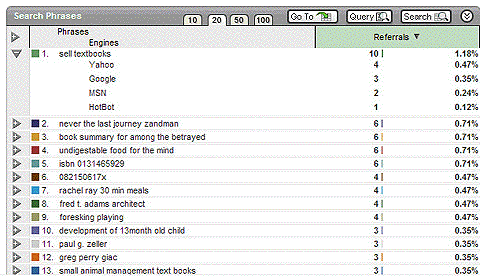This site is for sale,
Learn More
Measuring Web Site Statistics as Part of Your SEO Strategy
Measuring The Behavior Of Visitors And Spiders
By Mark Nelson
Originally Published: February, 2005
Measuring the behavior of visitors and spiders should be an integral part of your optimization efforts. In recent articles we have focused on the important areas of the SEO process including:
-
Keyword research and selection
-
Keyword placement throughout the web page
-
Internal site linking structure
-
Offsite link popularity
All of these areas are essential in driving qualified traffic to your site, but what happens when your SEO efforts begin to pay off and you start to see an increase in visitor traffic? Measuring the onsite behavior of your visitors and spiders is essential, not only in gauging the effectiveness of your optimization efforts, but in measuring the effectiveness of your website design in converting those visitors to buyers.
In this article we will provide you with an overview of web analytics, explore how to leverage the most basic web analytics information and explain how it can help in the SEO process. For SEO and online marketing in general, the most fundamental metrics to focus on are visits, page views and referrals. Below is a brief description of each metric and its value in the SEO process:
Basic Web Analytics Metrics
Visits
A visit is a series of actions that begins when a visitor views their first page from your site, and ends when the visitor leaves your site or remains idle for a period of time (usually 30 minutes). Looking at visit trends over time for your site is an effective way to measure the overall impact of your optimization efforts. Although there are usually seasonal and cyclical factors that affect visitor traffic, the more history you can collect, the better you will be able to isolate, identify and measure SEO changes that were responsible for the increase in traffic volume. It is also important to measure conversions or leads to ensure the traffic you are attracting consists of visitors genuinely interested in you content. For example, in your keyword selection, you may have chosen a term that was too general and that has attracted a different audience than you intended.
Page Views
In order to view a web page with embedded images, a browser must retrieve multiple files. The page and its embedded files counts as a single page view. Understanding how many page views and which pages are being viewed is important in gauging the effectiveness of keywords research and selection. Knowing how many visitors viewed a specific product or category page is a very good indication of the success of selecting and optimizing for a specific key phrase.
Referrals
A referral is a web page that contains a link to one of your site pages that was used by a visitor to get to your site. One of the most useful search engine reports in WebTrends, a leading provider of web analytics solutions, is the Search Phrases report. This report will give you a count of key phrases for each search engine. Understanding where your referrals are coming from is essential in fine tuning your keywords. Most of your traffic will come from search engines, but not all traffic. You will also receive traffic from other non search engine sites linking to your site. The Search Phrases report is also useful in what it doesn’t show. Target keywords that do not show on a search phrase report should raise a flag and prompt investigation to determine the cause.

|
|
WebTrends Search Phrases Report
|
Measuring Spider Traffic
The basic metrics should also be used to measure search engine spider traffic. Knowing which pages spiders have traversed, the depth of the crawl, and how often they visit can provide valuable insight into the effectiveness of the site’s design and internal linking structure.
Spider Crawl Depth
The depth of a spiders visit refers to how much of the site’s content is traversed and indexed by the spider. When looking at a typical website design hierarchy, you may have product, category and informational pages. It’s important to understand which content in a particular area is visited by spiders because most spiders will not visit all of the pages of a site. The number of pages visited will depend on many factors, but is usually most dependent on how important the site is viewed by the particular search engine. The importance of a site is, of course, determined by offsite links, page content and themes. The most important content should be placed as close to the top of the site’s hierarchy as possible to maximize the exposure of the content to the greatest number of search engine spiders.
Spider Visit Frequency
Understanding how often a spider visits a site can give insight into how the search engine views your site’s content and importance. For many search engines, the more important the site is viewed, the more frequently it will be visited. This can obviously be an important indication of the success of your SEO efforts.
Spider Path Analysis
Knowing the path a spider takes when traversing a site can provide a wealth of information that can help in identifying broken links or other site design problems. Some of the most important information that can be gleaned from spider path analysis is knowledge of paths that are not taken. Identifying these paths and correcting the cause for the lack of traffic can have a dramatic effect on a site’s visitor traffic, page views and ultimately, ROI. Some examples of issues that may be brought to light with spider path analysis include:
-
Unintended robot exclusions in robots.txt or meta tags
-
URL’s containing a session id that prevent spider traversal
-
Site design problems in the internal linking structure
-
Broken internal links
Editor's Note:
See Also:
A Comprehensive Strategy for Using Web Site Statistics
This article is copyrighted and has been reprinted with permission from FirstPlace Software.
Site Promotion Articles Indexes:
|


![]()